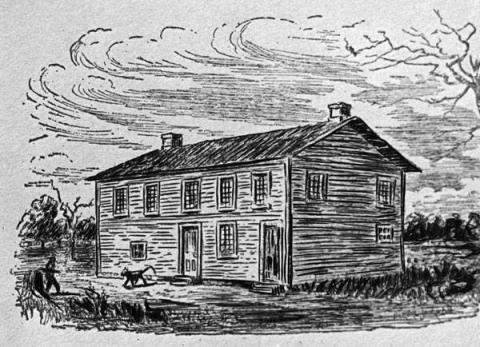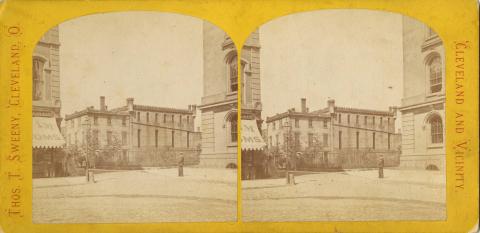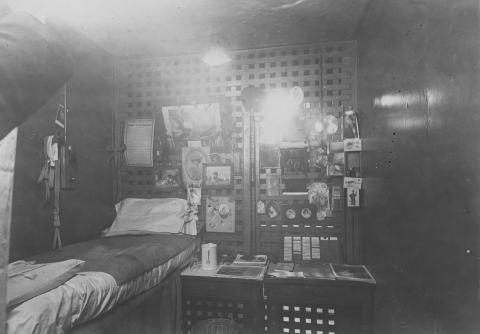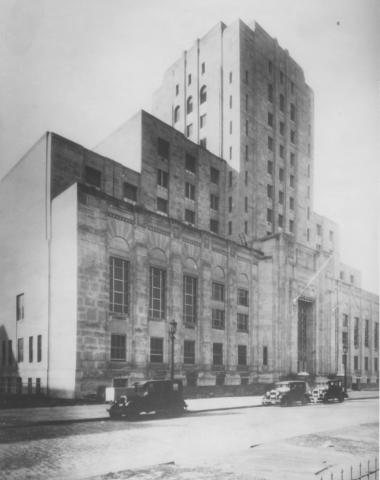The CUYAHOGA COUNTY JAIL is a detention facility for people who are charged with crimes and awaiting trial in Cleveland, Ohio. The jail has been housed in six different facilities since 1813, with its current facility located in the Cuyahoga County Justice Center, which also houses the Cleveland Police Headquarters and the Cuyahoga County and Cleveland Municipal Courts. Throughout its history, the poor conditions faced by people incarcerated at the Cuyahoga County Jail have consistently been a point of criticism and have historically motivated the construction of new facilities.
The first building to house the Cuyahoga County Jail was the CUYAHOGA COUNTY COURTHOUSE, built in 1813. The facility consisted of a two-story log building containing several jail cells, a living room for the sheriff’s, and a courtroom on the second floor. In 1828, the second Cuyahoga County Court House was completed, and the old facility was demolished in 1830. The jail moved with the new courthouse to the southwest corner of Monumental Park, which is now PUBLIC SQUARE.
The jail was relocated again in 1858 following the completion of the third Cuyahoga County Courthouse, located at the northwest corner of Public Square. The jail was housed in a building connected to the court house. Government officials praised the 120-cell jail for its cleanliness and order, but people incarcerated at the jail described its conditions much differently in local newspapers. In 1886, the Cleveland PLAIN DEALER published an account of life in the jail written by an anonymous detainee which described prisoners being routinely served rotten meat. In 1899, another incarcerated person wrote a story on jail conditions for the Plain Dealer which described uncontrolled infestations of rats, cockroaches, and other vermin in the jail, filthy and infested bedding in the cells, inedible food, and a constant odor coming from the jail’s uncovered sewage system.
In 1875, a new county courthouse and jail were constructed near Public Square on West 3rd Street in order to address overcrowding and poor conditions in the facilities, but by the turn of the century, government officials had already begun to call for the construction of a new jail due to worsening conditions. Plans to construct a new criminal court building and a new jail were proposed in 1903 and approved in 1904, but construction of a new jail was halted after an injunction because the cost had not been approved by Cuyahoga County voters. In 1912, a new Cuyahoga County Courthouse at 1 Lakeside Avenue was completed as a part of a beautification plan for the city, but the facility housed only the civil division of the Court of Common Pleas, while the criminal division and jail remained in the old facility.
Calls to construct a new jail due to poor conditions at the 1875 facility continued to grow in the following years. From 1911 to 1915, reports on the jail written by county grand jury members consistently recommended the construction of a new jail due to inadequate ventilation and sanitation at the old facility. As the jail’s population continued to grow, overcrowding at the facility became a more serious problem, and two prisoners were routinely held in cells designed to hold only one. In 1923, the State of Ohio ordered significant changes to the Cuyahoga County Jail to address issues of inadequate capacity, sanitation, and ventilation, noting that voters had rejected bond measures to fund a new jail numerous times in the preceding years. It was not until November of 1928 that Cuyahoga County voters approved a bond measure to construct a new criminal courthouse and jail facility in order to relieve these issues.
In 1931, the Cuyahoga County Criminal Courts and Jail moved to a new building on East 21st Street, and the facility was praised in the following years for its better conditions. In 1934, the report of a former Cuyahoga County grand jury foreman, who was tasked with inspecting the jail’s facilities, praised the food, housing, and religious services that were being provided. Following the completion of a remodel of the fourth floor and entrance in 1940, Sheriff Martin L. O’Donnel said that the jail was safe and sanitary for the first time in many years. However, conditions declined over the years, and by the 1960s, the jail was facing serious issues with staffing and overcrowding. In January 1968, a report written by a retiring county grand jury foreman recommended the immediate construction of a new jail facility due to serious overcrowding, with the jail housing up to 750 prisoners at a time when it was only designed to hold 350. In November of that year, however, voters rejected two bond measures for the purchase of land and the construction of a new city and county Justice Center.
The declining conditions became intolerable to people incarcerated in the jail. On March 27, 1969, around 150 incarcerated people housed on the three floors of the jail set fire to their mattresses and sheets in a demonstration against overcrowding and the harsh security measures that had been implemented to control it, including new restrictions on visitation. The fires were extinguished by firemen from Cleveland’s First Battalion, and protesters were forced back into their cells by the jail’s deputies armed with tear gas grenades after three hours. Following the prisoners’ demonstration, an emergency meeting was held at City Hall, and an immediate agreement was reached between Sheriff Ralph E. Kreiger, Mayor Carl B. Stokes, and the Cuyahoga county commissioners to send 100 prisoners to the Cleveland-owned Warrensville Workhouse (See also: CLEVELAND WORKHOUSE).
Despite action to reduce the jail’s population, conditions at the jail continued to deteriorate, and overcrowding remained a serious problem. In August of 1969, U.S. District Court Judge Thomas D. Lambros launched an inquiry into treatment of federal prisoners at the Cuyahoga County Jail after multiple complaints about deplorable conditions faced by inmates. In December of that year, Common Pleas Judge John L. Angelotta, the presiding judge at the Criminal Courts Building, ordered the jail to accept no new prisoners until the jail’s population had been reduced to under 600 inmates, a number still exceeding the jail’s capacity by 250.
In November of 1970, Cuyahoga County voters passed a bond measure to fund the proposed Justice Center. Construction on the site began in October of 1971 and was completed in 1976. The jail was built with 886 beds, and by 1979, overcrowding was once again an issue. By 1985, city and county officials were already considering plans to construct a second jail. In 1990, the jail’s population was regularly 50% above capacity. Plans to construct an additional facility were realized in 1994, when a second jail at the Justice Center complex was completed, adding 480 beds. By 1999, however, the Cuyahoga County Jail was once again overcrowded and began sending prisoners to suburban county jails to reduce its inmate population In 2002, the Cleveland fire marshal ordered the jail to reduce overcrowding after an inspection found that 2,300 inmates were held at the facility, far exceeding its capacity. Consistent overcrowding and staffing issues continued to worsen conditions in the jail, making it difficult to provide adequate nutrition, healthcare, hygiene, and rehabilitative programs.
In 2018, significant attention was drawn to worsening conditions at the jail due to a series of deaths and a federal investigation that revealed serious issues at the facility. Following seven inmate deaths at the facility, six Cuyahoga County Common Pleas Court Judges wrote letters in November to county and health officials calling on them to address conditions in the jail, including overcrowding and inadequate medical care. Later that month, the U.S. Marshals Services released a report on conditions at the jail and found serious issues in the its operations, including inadequate access to basic hygiene, inadequate food provisions that failed to meet daily caloric and nutritional needs, inadequate health services, improper juvenile detention practices, noncompliance with the Prison Rape Elimination Act, and serious staffing shortages leading to inhumane restrictions on inmate movement. Following the release of the report, the U.S. Marshals announced that they were removing federal inmates from the Cuyahoga County Jail.
Continued poor conditions at the jail have led to recent discussions to construct a new facility or renovate the existing jail in order to relieve overcrowding and improve conditions declining due to the deterioration of the building over time. In 2019, Cuyahoga County and the City of Cleveland reached an agreement to commission a study on the Cuyahoga County Jail to determine whether it should be renovated or replaced. Discussions on constructing a new jail facility or renovating the existing facility have continued into 2022, with no firm decisions being reached by city or county officials.
Sidney Negron
Last Updated: 8/22/2022
View image of the third Cuyahoga County Jail at Cleveland Public Library.
View image of a cell in the Cuyahoga County Jail in 1910 at Cleveland Public Library.
View image of the first Cuyahoga County Courthouse at Cleveland Memory.
“Action Follows 3-Hour Riot.” Plain Dealer (Cleveland, Ohio), March 28, 1969: 1.







